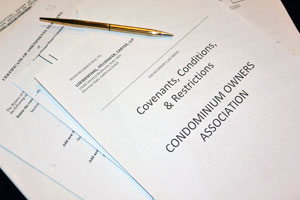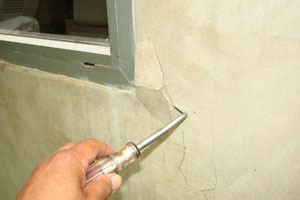LHC Newsletter Vol. 2, No. 3
“The Risk of Deferred Maintenance, Pay Now or Pay More Later”
By David A. Loewenthal,Esq
Common interest developments – CID’s (e.g.: planned unit developments, condominiums, or cooperatives) have proliferated greatly over the past 30 to 40 years throughout California and the U.S. Whatever one’s feelings about living in a CID, one thing is clear: the financial interests of all members residing within the community association are tied together.
One of the primary duties of a board of directors of a homeowners association is to preserve the values of the properties contained therein. Given that some CID properties are now reaching 40 years of age and more, long-term, infrastructural issues have come to the fore. Ordinarily, repairs are funded through regular assessments which are designed to cover both the monies necessary for operating expenditures (e.g.: insurance, utilities, management, accounting, etc.) and for reserves which fund replacement of component parts once their useful life has been met. (See Civil Code § 1366).
Reserve funds are only to be spent for the purposes of repairing, restoring, maintaining, replacing major component parts or pursuing litigation involving the repair, restoration, replacement or maintenance of major component parts of the common interest development which the homeowners association is required to maintain. See Civil Code § 1365.5(c)(1).
Based upon the amount of money that is needed for operating and reserve, the pro forma budget is to be prepared, approved by the board and distributed to the members. Unfortunately, it is also this misstep that can become the downfall of an association. Specifically, when an association’s board of directors improperly budgets for reserves, either on purpose or by oversight, year after year, an increasing shortfall develops. This shortfall may ultimately lead to a disaster for the association in the form of substantial deferred maintenance which may cause irreparable harm to its members.
Homeowners associations that do not take the responsibility for properly assessing its members and thus obtaining money to reserve for component parts at the beginning of the life of an association will condemn future owners to the reality of potentially large special assessments to fund the reserve accounts.
When there have been year after year failures to properly reserve, an increase in the regular assessment of 20% and/or a 5% special assessment, which the Board of Directors can implement pursuant to Civil Code § 1366, may fall woefully short of the real cost of repairs.
As such, the board may ultimately need to go to the membership in the hopes of having a special assessment passed in a sum sufficient to perform the appropriate repairs and/or replacements. However, again, this requires a majority vote of a quorum of the membership. Since homeowners often vote with their checkbook, the passage of large special assessments is often difficult to obtain. In addition, when there is an attempt to pass large special assessments to pay for these items, arguments are generally raised by members which include, but may not be limited to, the following:
1. Why should we have to pay for this now, we did not cause the problem?
While newer members of the association may not have reaped the benefits of several years of deferred maintenance caused by artificially low assessments, these owners benefit going forward given that large portions of any association may include common areas and/or infrastructure. Also, lenders will often look at the percentage of an Association reserve in deciding whether or not to provide loans for purchases and/or refinancing existing loans.
2. How did the board of directors allow this to happen and can we sue them?
Typically, homeowners will seek to pass blame onto the decision makers of the association, i.e., the board of directors. Members would need to look to see whether or not the current board has also been in power for many years and did in fact contribute to the shortages, or if they are simply the board that is now attempting to right the ship. Although an association’s membership could seek to sue the current board or prior boards of directors for negligence and/or breach of fiduciary duties, it will be a difficult process. Moreover, it is one that will require careful consideration and most likely will be costly.
3. Can we simply patch up the problem and put it off to the future?
This is probably what created the problems in the first place i.e., patching and deferral versus properly reserving for repair and/or replacement of major component parts so that the money is available when necessary. Patching and deferral will only last so long and over time will create a snowball effect which will cause greater and more significant damage to the association.
4. Can the board simply pass an emergency assessment?
This is a tricky area of the law since emergency assessments are specifically limited by the Civil Code. Civil Code § 1366(b) provides for three (3) distinct situations where a board of directors may unilaterally pass an emergency assessment without the consent of the membership, which are as follows:
a. An extraordinary expense required by an order of a court;
b. An extraordinary expense necessary to repair and maintain the common interest development or any part of it for which the association is responsible where a threat to personal safety on the property is discovered;
c. An extraordinary expense necessary to repair or maintain the common interest development or any part of it for which the association is responsible but could not have been reasonably foreseen by the board in preparing and distributing the proforma operating budget under § 1365.
If an association is still young enough, it is possible that an association may also file a claim against a developer for construction defects and under reserving. The developer creates the original budgets and represents to the buyers the amount of assessments at the time of purchase which should include amounts necessary to fund for both operating and proper reserving. Failure to so budget by the developer may be actionable. Often times in construction defect lawsuits
against the developer, claims of under reserving are in fact included.
Again, homeowners in common interest developments, especially condominium projects, cannot escape the costs that are necessary to properly maintain the project and its component parts. The old saying of pay me a little bit now or a lot later clearly applies to homeowners associations more so now than ever in the past.
Foreclosure Rates Increase – HOA revenues will continue to be challenged
According to DataQuick Information Systems’ California Foreclosure Report: “Last quarter’s (4th Qtr. 2007) default numbers were a record in 42 of the state’s 58 counties. In Los Angeles County it was 63.5 percent of the first-quarter 1996 peak… Of the homeowners in default, an estimated 41 percent emerge from the foreclosure process by bringing their payments current, refinancing, or selling the home and paying off what they owe. A year ago it was about 71 percent.”
These data should serve as a serious warning to Associations and their managers that delinquent assessments and related collection problems will continue and probably worsen, and that aggressive and proactive steps will need to be taken to mitigate unnecessary losses of Association revenues. In the current real estate market, the “one size fits all” approach of nonjudicial or judicial foreclosure does not work.
One of the aggressive and proactive steps which Board’s can take is to conduct an analysis of each delinquent account to pick the best remedy for the factual situation and to undertake this analysis sooner than ever before. LHC has developed and has used for years a straightforward analytical approach to assist Boards in choosing the remedy most likely to get results in a cost effective way. Please contact us if you have any questions concerning the proper analysis to use to maximize recovery and minimize expenditures for that recovery.
© 2007 by Loewenthal, Hillshafer & Carter, LLP. All rights reserved. Permission is granted to reproduce or transmit in any form any part of this newsletter as long as proper attribution to Loewenthal, Hillshafer & Carter, LLP is given. Due to the rapidly changing nature of the law, information contained in this publication may become outdated. As a result, lawyers and all others using this material must research original sources of authority.


